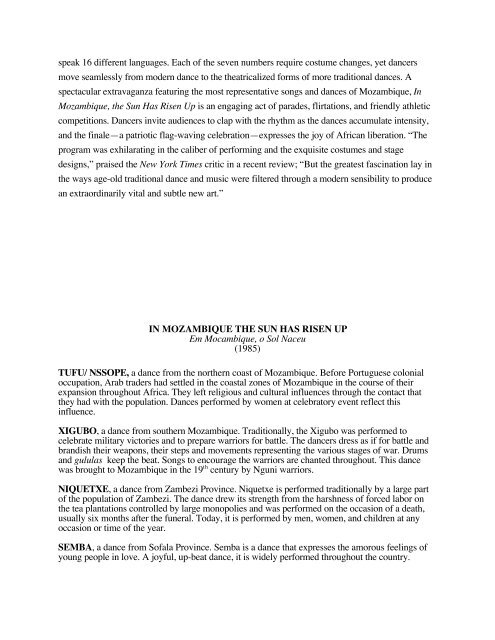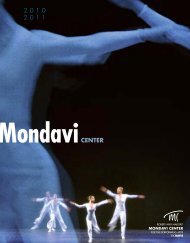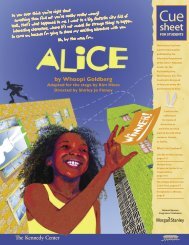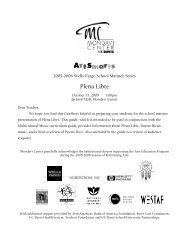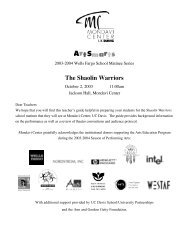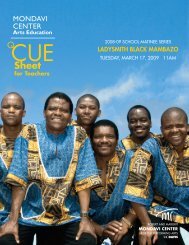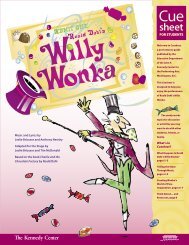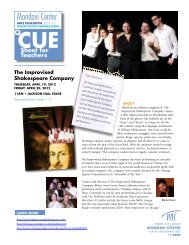National Song and Dance Company of Mozambique
National Song and Dance Company of Mozambique
National Song and Dance Company of Mozambique
You also want an ePaper? Increase the reach of your titles
YUMPU automatically turns print PDFs into web optimized ePapers that Google loves.
speak 16 different languages. Each <strong>of</strong> the seven numbers require costume changes, yet dancersmove seamlessly from modern dance to the theatricalized forms <strong>of</strong> more traditional dances. Aspectacular extravaganza featuring the most representative songs <strong>and</strong> dances <strong>of</strong> <strong>Mozambique</strong>, In<strong>Mozambique</strong>, the Sun Has Risen Up is an engaging act <strong>of</strong> parades, flirtations, <strong>and</strong> friendly athleticcompetitions. <strong>Dance</strong>rs invite audiences to clap with the rhythm as the dances accumulate intensity,<strong>and</strong> the finale—a patriotic flag-waving celebration—expresses the joy <strong>of</strong> African liberation. “Theprogram was exhilarating in the caliber <strong>of</strong> performing <strong>and</strong> the exquisite costumes <strong>and</strong> stagedesigns,” praised the New York Times critic in a recent review; “But the greatest fascination lay inthe ways age-old traditional dance <strong>and</strong> music were filtered through a modern sensibility to producean extraordinarily vital <strong>and</strong> subtle new art.”IN MOZAMBIQUE THE SUN HAS RISEN UPEm Mocambique, o Sol Naceu(1985)TUFU/ NSSOPE, a dance from the northern coast <strong>of</strong> <strong>Mozambique</strong>. Before Portuguese colonialoccupation, Arab traders had settled in the coastal zones <strong>of</strong> <strong>Mozambique</strong> in the course <strong>of</strong> theirexpansion throughout Africa. They left religious <strong>and</strong> cultural influences through the contact thatthey had with the population. <strong>Dance</strong>s performed by women at celebratory event reflect thisinfluence.XIGUBO, a dance from southern <strong>Mozambique</strong>. Traditionally, the Xigubo was performed tocelebrate military victories <strong>and</strong> to prepare warriors for battle. The dancers dress as if for battle <strong>and</strong>br<strong>and</strong>ish their weapons, their steps <strong>and</strong> movements representing the various stages <strong>of</strong> war. Drums<strong>and</strong> gululas keep the beat. <strong>Song</strong>s to encourage the warriors are chanted throughout. This dancewas brought to <strong>Mozambique</strong> in the 19 th century by Nguni warriors.NIQUETXE, a dance from Zambezi Province. Niquetxe is performed traditionally by a large part<strong>of</strong> the population <strong>of</strong> Zambezi. The dance drew its strength from the harshness <strong>of</strong> forced labor onthe tea plantations controlled by large monopolies <strong>and</strong> was performed on the occasion <strong>of</strong> a death,usually six months after the funeral. Today, it is performed by men, women, <strong>and</strong> children at anyoccasion or time <strong>of</strong> the year.SEMBA, a dance from S<strong>of</strong>ala Province. Semba is a dance that expresses the amorous feelings <strong>of</strong>young people in love. A joyful, up-beat dance, it is widely performed throughout the country.


